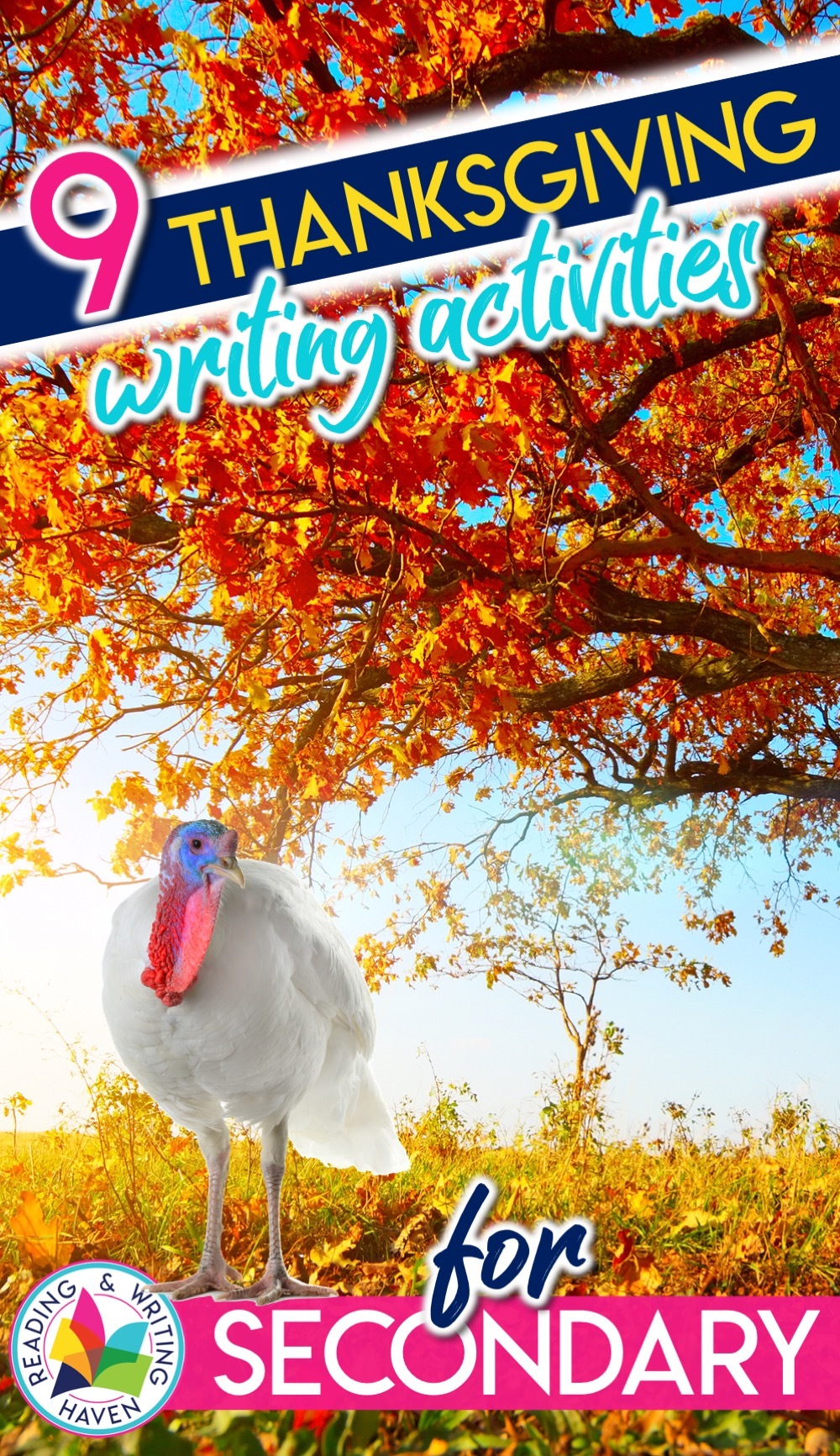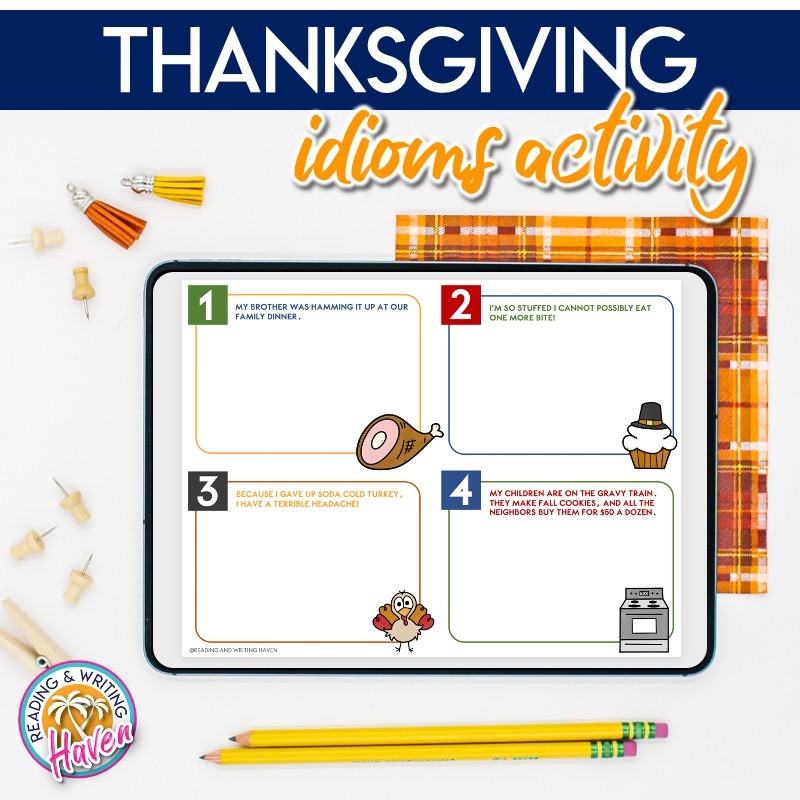Simple Yet Meaningful Thanksgiving Writing Activities
Looking for a way to engage your secondary ELA students this holiday season? Try using simple yet meaningful Thanksgiving writing activities to keep your classes focused and interested during those final days before fall break.
It can be challenging to think of ways to keep middle and high school students engaged around the holidays. Through trial and error, I’ve found that the best approach is to channel their energy about the upcoming season in lessons instead of plowing through our units as usual. But how? It’s also important to maintain the integrity and rigor of our curriculums. I have a few ideas.

THANKSGIVING WRITING ACTIVITIES
1. Thank You Emails
Asking students to practice writing thank you emails (or letters!) blesses others and also helps students to hone their real-world writing skills. This year, especially, people can use a few kind words to lift their spirits. Here’s a free lesson you can download to get started. Spread positivity and encouragement around the world.
2. Turkey Pardon Plea
Get creative. Read this article and Watch this video clip about the United States’ Thanksgiving tradition of pardoning turkeys. Then, have students participate in a creative writing assignment. Ask them to take on the persona of a turkey who is vying for that coveted spot of being pardoned to a life of luxurious retirement. In their piece, students should work on developing a specific voice. How would a turkey in this situation share his or her plea? Would it be most effective to be humorous, desperate, cunning, argumentative, defensive, or despondent? Write along with your teens, and have fun laughing as you share your responses.
3. Write about Theme
As a class, watch this video clip. Have students respond to the narrator’s message and the symbolism of the images. What is the central idea or theme of this inspirational, nonfiction clip? How do the film creator and narrator develop it?
Or, watch this short film. Use this video as an opportunity to write about theme. Ask students to brainstorm possible lessons viewers should take away from this story, and then begin identifying text evidence that supports the development of the theme. This video clip would also work well for making personal connections with the theme. If students need ideas of where to start, you may want to host a brief discussion about how Thanksgiving is a wonderful time for us to express empathy and compassion for others who may be hurting.
4. Figurative Language
Memes can be an engaging way to incorporate informal Thanksgiving writing activities into the classroom. Pictures often communicate an idea far better than a paragraph of words. As a class, study some examples of irony, comedy, or allusion in Thanksgiving memes. Then, encourage students to create one of their own to share! You will find plenty of examples if you search Google for “Thanksgiving memes.” Be sure to preview them and save your favorites as they are not all school appropriate!



Another way we can incorporate figurative language into our holiday lessons is by studying holiday idioms and expressions. What types of phrases do English speakers use this time of year that have both a literal and figurative meaning? This lesson is important when studying formal versus informal language as well as with ELL students who are not familiar with the figurative meanings.
5. Picture Book Patterns
Try reading picture books about thankfulness. A few of my favorites are How to Catch a Turkey by Adam Wallace, Dav Pilkey’s ‘Twas the Night Before Thanksgiving, Room for Everyone, and A Little Thanksgiving SPOT by Diane Albers. Ask students to get together in small groups and discuss behaviors, attitudes, and dialogue that convey an attitude of gratitude. Do the characters in each book do similar things…or different? Then, ask students to reflect on how they personally show thankful hearts. In the midst of daily stressors, how can setting our minds on what we have to be thankful for keep us healthy?
6. Documentary Analysis
Watch the high-interest and unique documentary My Life as a Turkey. As students watch the film, they can practice a variety of reading strategies. For example, have them keep a t-chart with a running list of questions the movie make them think of and possible answers. Students can also include interesting facts and thoughts about them on the t-chart. With this documentary, students can make a variety of inferences and predictions, summarize and sequence, and even analyze the theme of an informational text.
7. Gratitude Mindfulness Journaling
Have students complete some gratitude journaling. These low stakes writing assignments teach students about a specific social emotional element of thankfulness. For example, exercising can increase our mental health and help us to feel more grateful! As students write, they can also color and doodle, making this journaling activity perfect for a bell ringer. Students can participate in a rhythmic, calm writing session to regulate themselves for the class period that lies ahead.

8. Top 10 List
Families appreciate when students bring home information to share at the Thanksgiving dinner table. Ask students to write a Top 10 list of what they are most thankful for. BUT! Don’t make this just any old list. If you want to add a twist of fun, watch Kid President’s 25 Things to be Thankful For video and then generate an equally light-hearted list.
For an added level of difficulty or to differentiate, you could also have them research Thanksgiving and write down the Top 10 most interesting facts about the holiday or the Top 10 Thanksgiving myths everyone believes. Students could then turn their research into a 3 Truths and a Lie game to share their findings. To further tie this activity into your writing standards, have students work on properly citing their facts in MLA format.
9. Research Then and Now
People too often celebrate holidays without asking important questions about why they are significant, what they mean, and how they’ve evolved. Ask students to research the origin of Thanksgiving. How did it begin? What was it like? How do their findings compare with the cultural norms surrounding their Thanksgiving today? Allow students to explore differences in Thanksgiving traditions, and give them time to talk about how each of their experiences is unique.
Learning during the holiday season can be fun, even in the secondary classroom! Try one (or more) of these ideas this Thanksgiving writing activities to engage your students and share some laughter.
READ NEXT:
- 10 Fun Literary Analysis Activities
- Short Films and Poetry for Paired Text Analysis
- Ideas for Analyzing Children’s Books

